Nicolas Galtier
The power of pattern
While the work of Nicolas Galtier relates to, in its appearance, a style of painting that art history has dubbed “pattern painting” (that’s to say, painting that focuses on design, texture, and lighting rather than on figuration), it’s completely off the mark to see this work simply as decorative painting. Pattern, for this artist, is not merely coterminous with a search for balance and harmony, but is doubled with an ambition to turn this purely aesthetic quest into the point of departure for a new approach to the vision and energy that is contained within this pursuit of balance: “In each of my paintings,” writes Nicolas Galtier, “I would like to succeed in translating the presence of the sacred and, in the same movement, give the sense that the sacred is simply a level of appearance, an attitude of the Spirit toward the images it creates.” It is toward such an attitude of the Spirit that we will now meditate on.
The power of Pattern
“The archetype is part of a frame of representations related to each other, always leading to other archetypal images and constantly overlapping each other, and which together form the single tapestry of life.”
C.G. Jung
Let’s first ask: what, exactly, are the images that Galtier creates? Even more precisely, to which order of reality do they actually belong? To this double question, we must, to begin with, respond: the images are of echoes, traces, reminiscences of that which humanity, throughout its history (and the diversity of its cultures, mentalities, arts), has managed to capture from the Form-Archetypes that inhabit the unconscious—the forms that are not only at the foundation of our understanding of the world (as symbolic forms) but that also relate to certain primitive emotions that are true “potential psychic energy”1. In effect, each and every pattern, every ornament in Galtier’s work seems to strive to evoke, beyond the link that relates to a particular culture, time, or style (from prehistory to the world of contemporary design, passing through Etruscan and Byzantine civilizations, etc.), the presence of a “sacred geometry” whose function would be to successfully activate the parts of our brains that, in our daily lives, we hardly exercise, if at all. In other words, Galtier’s images are not only his creations (in the sense that he would be the subjective author) but rather the creations of a Spirit with whom Galtier participates; a Spirit who, at once, engulfs, surpasses, and illuminates him.


“In all cultures, there is a variation of patterns. The golden ratio. The architecture. All this is linked. There is a collective intuition of pattern. It’s what I call ‘a sacred geometry.’ It’s from such a geometry that my work unfolds.”
Yet, to this “sacred geometry” that gives the work of Galtier its vocabulary, we must add one more element for our interpretation to be complete. These creations not only expose us to the Form-Archetypes, but also put these Forms in contact with a power that, all while altering the shapes it supports, also infuses them with the fragile elegance or, better yet, the pathetic beauty of a being, a thing, who unfurls while erasing itself. While, on one hand, the works of Galtier show us, under multiple facets (that constantly vary with a play of light created by powders and metal sheets—gold, silver, copper, bronze, iron—used in the creation of each of his paintings) the Forms—the patterns— on which stands the symbolic order of our world, on the other hand these works show us the Forms as being always-already taken in the encompassing movement of a flow, a duration, that brings them to the state of their simple potentiality. In other words, in the work of Galtier, that which we see is not only pattern as decoration, nor ornament as indication of a “sacred geometry”, but the paradoxical movement that unites, in a coincidence of contradiction, the vertical movement of Form-Archetypes to the horizontal movement of linear time: “Each of my paintings is a passage. A passage to go to the beyond, and this beyond is not defined. When I talk about the divine, I talk about the human that goes further than the human. My paintings are but receptacles of this inspiration. Everything is a question of vision. To awaken the sacred, and help others feel it. This is the ultimate goal of my painting.”
Translation: Cassandra Katsiaficas
Frédéric-Charles Baitinger
Nicolas Galtier is a French artist.
www.nicolas-galtier.com/fr/presentation
